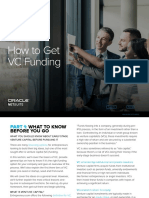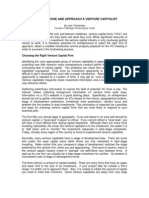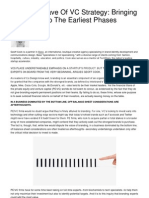0 ratings0% found this document useful (0 votes)
45 viewsCase Onlink
Case Onlink
Uploaded by
Nikita SemkinOnLink initially struggled to raise funding from venture capital firms during their early stages. They did not have a large target market and were in a new technology industry, which VC firms tend to avoid. However, after growing the company by targeting larger customers and increasing revenues, OnLink was better positioned to attract VC investment. Buck updated the business plan and targeted top-tier VC firms that would understand OnLink's story. With a major customer and fulfilling criteria like seeking rapid growth and an IPO, OnLink gained the attention and confidence of VC firms like they prefer for investments.
Copyright:
Attribution Non-Commercial (BY-NC)
Available Formats
Download as PDF, TXT or read online from Scribd
Case Onlink
Case Onlink
Uploaded by
Nikita Semkin0 ratings0% found this document useful (0 votes)
45 views1 pageOnLink initially struggled to raise funding from venture capital firms during their early stages. They did not have a large target market and were in a new technology industry, which VC firms tend to avoid. However, after growing the company by targeting larger customers and increasing revenues, OnLink was better positioned to attract VC investment. Buck updated the business plan and targeted top-tier VC firms that would understand OnLink's story. With a major customer and fulfilling criteria like seeking rapid growth and an IPO, OnLink gained the attention and confidence of VC firms like they prefer for investments.
Original Description:
Onlink
Original Title
Case_OnLink
Copyright
© Attribution Non-Commercial (BY-NC)
Available Formats
PDF, TXT or read online from Scribd
Share this document
Did you find this document useful?
Is this content inappropriate?
OnLink initially struggled to raise funding from venture capital firms during their early stages. They did not have a large target market and were in a new technology industry, which VC firms tend to avoid. However, after growing the company by targeting larger customers and increasing revenues, OnLink was better positioned to attract VC investment. Buck updated the business plan and targeted top-tier VC firms that would understand OnLink's story. With a major customer and fulfilling criteria like seeking rapid growth and an IPO, OnLink gained the attention and confidence of VC firms like they prefer for investments.
Copyright:
Attribution Non-Commercial (BY-NC)
Available Formats
Download as PDF, TXT or read online from Scribd
Download as pdf or txt
0 ratings0% found this document useful (0 votes)
45 views1 pageCase Onlink
Case Onlink
Uploaded by
Nikita SemkinOnLink initially struggled to raise funding from venture capital firms during their early stages. They did not have a large target market and were in a new technology industry, which VC firms tend to avoid. However, after growing the company by targeting larger customers and increasing revenues, OnLink was better positioned to attract VC investment. Buck updated the business plan and targeted top-tier VC firms that would understand OnLink's story. With a major customer and fulfilling criteria like seeking rapid growth and an IPO, OnLink gained the attention and confidence of VC firms like they prefer for investments.
Copyright:
Attribution Non-Commercial (BY-NC)
Available Formats
Download as PDF, TXT or read online from Scribd
Download as pdf or txt
You are on page 1of 1
TU-91.
2038 Strategies for Growth and Renewal
Nikita Semkin 79049K
Case OnLink __________________________________________________________________
Even though Buck and the team of OnLink contacted several Venture Capital companies during their first attempt to raise funding they didnt manage to get a single company interested in them, let alone to invest money in them. They managed to get a meeting with with a VC company called Sierra Ventures, but they didnt feel that companys target market was of particular interest to them. As Buck himself said The market was defiantly not there yet and that VCs then were far more interested in business-to-consumer internet companies. Their earlier trials and Venture Capital firms reactions are similar to those described in Bob Ziders article How Venture Capital Works. According to Ziders, VC-firms avoid the early stages of a company or a new technology instead they focus. On contrary to popular belief, they also don t invest in good ideas or good people but instead in good industries. OnLink was then just a good idea with good people in a new technology business. Ziders also mentions that VC-companies are interested in potential companys management, and as happened with OnLink they lost a crucial member when they were trying to close a deal. Partly because they replaced him with a person of lower qualification the deal collapsed. After the initial failures Buck decided to focus on growing the company. They targeted biggest players of the industry while trying to grow and reinvent themselves. He started targeting companies in the Fortune 200 list, trying to find a customer with a strong brand. After that they focused on increasing revenues. They managed to do it raising prices on their products, something that is also suggested in Nil C. Churchills and John w. Mullinss article How Fast an your company grow. During this time Buck also rewrote the business plan and started targeting VC s again. As he put it We followed the strategy of targeting top tier firms with a partner whi would understand our story. This matches to the profile of the ideal entrepreneur represented in Ziders article. He now also had a big company as a client that he could use to gain attention from VCs. Buck also managed to fulfill more criterias of ideal entrepreneur. He recognized the need for speed and he was aiming to an IPO. He also managed to win Daves (from Sierra Ventures) confidence. He also happened to be sought after an another VC. The state of the company was also suitable, as according to Ziders article. They had already established a position and they were in a business with a lot of potential for growth. Something that VCs tend to look for.
You might also like
- Case - Merck and Company SolutionDocument8 pagesCase - Merck and Company SolutionMrShyamkumarpaswan0% (1)
- CB Insights - What Is Venture CapitalDocument37 pagesCB Insights - What Is Venture CapitalEnrico RecchiNo ratings yet
- Your Guide To VC Funding: Prev NextDocument34 pagesYour Guide To VC Funding: Prev NextAndrew OseniNo ratings yet
- Startup Finance PDFDocument15 pagesStartup Finance PDFMemberNo ratings yet
- Startup Finance PDFDocument15 pagesStartup Finance PDFMember100% (1)
- Malicious Intent - Nikolas Cruz's AccompliceDocument643 pagesMalicious Intent - Nikolas Cruz's AccompliceAlan Jules Weberman50% (4)
- Adamou Rantfor April 28,2010Document5 pagesAdamou Rantfor April 28,2010api-26372760No ratings yet
- Ebook How To Get VC FundingDocument35 pagesEbook How To Get VC FundingSaleha ShahidNo ratings yet
- Adamou Rantfor April 28,2010Document5 pagesAdamou Rantfor April 28,2010api-26372760No ratings yet
- BankNotes January 2024Document9 pagesBankNotes January 2024jerm.ladellNo ratings yet
- Meaning of Startup: Start UpsDocument8 pagesMeaning of Startup: Start UpsYour ProjectNo ratings yet
- Class 11 AssignmentDocument435 pagesClass 11 AssignmentMrabet SarahNo ratings yet
- Working Capital - Debt and Equity Finance PDFDocument52 pagesWorking Capital - Debt and Equity Finance PDFMirabel VidalNo ratings yet
- The Emerging Role of Venture Builders in Early-Stage Venture FundingDocument28 pagesThe Emerging Role of Venture Builders in Early-Stage Venture Fundingvenamr100% (1)
- Design A Business Model That Disrupts Your Competition Not Your CompanyDocument45 pagesDesign A Business Model That Disrupts Your Competition Not Your CompanyAman JauhriNo ratings yet
- Origin of A BusinessDocument66 pagesOrigin of A BusinessAKARSH SAXENANo ratings yet
- Venture Capital Thesis TopicsDocument4 pagesVenture Capital Thesis Topicssjfgexgig100% (2)
- A Kleiner Perkins Partner Explains What VCs Want To See in The Pitch From An Early-Stage Startup Markets InsiderDocument9 pagesA Kleiner Perkins Partner Explains What VCs Want To See in The Pitch From An Early-Stage Startup Markets InsiderJason MilesNo ratings yet
- Ultimate Guide Corporate Innovation - 0Document32 pagesUltimate Guide Corporate Innovation - 0vickNo ratings yet
- How To Choose and Approach A Venture CapitalistDocument5 pagesHow To Choose and Approach A Venture Capitalistmikes2ndNo ratings yet
- The Customer-Funded Business (Review and Analysis of Mullins' Book)From EverandThe Customer-Funded Business (Review and Analysis of Mullins' Book)Rating: 4.5 out of 5 stars4.5/5 (2)
- Allen Pandey March2024Document5 pagesAllen Pandey March2024Allen PandeyNo ratings yet
- Procurement of Venture CapitalDocument8 pagesProcurement of Venture CapitalLaxman SheralNo ratings yet
- BizLand IncDocument6 pagesBizLand Incoriginalsinner7No ratings yet
- Cajournal Jan2023 12Document4 pagesCajournal Jan2023 12ajitNo ratings yet
- Swoon in Tech Stocks Puts Startup Valuations in Harsh New Light - WSJ 2022.07.21Document4 pagesSwoon in Tech Stocks Puts Startup Valuations in Harsh New Light - WSJ 2022.07.21bafsvideo4No ratings yet
- How Company Founders Become TyrantsDocument14 pagesHow Company Founders Become Tyrantspape alassane kandjiNo ratings yet
- Capital Catalyst: The Essential Guide to Raising Funds for Your BusinessFrom EverandCapital Catalyst: The Essential Guide to Raising Funds for Your BusinessNo ratings yet
- Finding Business IdolsDocument9 pagesFinding Business Idolsanon-854235No ratings yet
- 15 Top Venture Capital Firms in The World (2023 Updated)Document17 pages15 Top Venture Capital Firms in The World (2023 Updated)Billy FowlerNo ratings yet
- Backdoor Listings: Seven Factors To Consider Before Shelling OutDocument2 pagesBackdoor Listings: Seven Factors To Consider Before Shelling OutStradlingNo ratings yet
- Venture FinancingDocument2 pagesVenture Financingminushastri33No ratings yet
- Raising Capital - Abalunan, A.RDocument2 pagesRaising Capital - Abalunan, A.RAmy Rose AbalunanNo ratings yet
- CB Insights What Is Venture CapitalDocument37 pagesCB Insights What Is Venture CapitalEnrico RecchiNo ratings yet
- Startup FundingDocument14 pagesStartup FundingViswanathan100% (1)
- BCG - Corporate Venture Capital (Oct - 2012)Document21 pagesBCG - Corporate Venture Capital (Oct - 2012)ddubyaNo ratings yet
- Andreessen Horowitz - Assignment QuestionsDocument4 pagesAndreessen Horowitz - Assignment QuestionsKrîzèllê B. MëndòzâNo ratings yet
- Module 2 The Venture Capitalist MinddsetDocument7 pagesModule 2 The Venture Capitalist MinddsetysiadoneromNo ratings yet
- Series A, B, C Funding: How It WorksDocument2 pagesSeries A, B, C Funding: How It WorksSachin KhuranaNo ratings yet
- Lec 02 EntrepreneurshipDocument56 pagesLec 02 Entrepreneurshipsamsonwasihun2No ratings yet
- CB Insights - What Is A SPACDocument22 pagesCB Insights - What Is A SPACPolina ChtchelockNo ratings yet
- Distinct Revenue-Based Financing Firm Meeting Great Need in Tech-Startup MarketDocument4 pagesDistinct Revenue-Based Financing Firm Meeting Great Need in Tech-Startup MarketPR.comNo ratings yet
- 11 Lessons From Venture Capitalist Fred WilsonDocument29 pages11 Lessons From Venture Capitalist Fred WilsonddubyaNo ratings yet
- E M - C5 - Case-StudyDocument3 pagesE M - C5 - Case-StudyPRINCESS LYKA MAE PALOMARNo ratings yet
- June 2011 TrialDocument21 pagesJune 2011 TrialjackefellerNo ratings yet
- Sequoia Capital India FinalDocument14 pagesSequoia Capital India FinalPallavi TirlotkarNo ratings yet
- The Great Inventions Fair BagrutDocument5 pagesThe Great Inventions Fair Bagrutapi-25895447No ratings yet
- Chap 1 Enterpreneurshipn CorrectDocument6 pagesChap 1 Enterpreneurshipn Correctammara tanveerNo ratings yet
- A Study On Venture Capital in Ludhiana CityDocument13 pagesA Study On Venture Capital in Ludhiana Cityparm_ryait8280No ratings yet
- How To Raise Collaborative Angel CAPITAL For Internet Business StartupFrom EverandHow To Raise Collaborative Angel CAPITAL For Internet Business StartupRating: 5 out of 5 stars5/5 (2)
- 4 Built To LastDocument15 pages4 Built To LastluckiemanNo ratings yet
- VC Strategy BrandingDocument3 pagesVC Strategy BrandingShwetaGoudNo ratings yet
- EBSCO FullText 2023 04 22Document12 pagesEBSCO FullText 2023 04 22Ricardo RNo ratings yet
- Assignment February'23 MEDocument3 pagesAssignment February'23 MEARYAN BNo ratings yet
- 10minutes - Self Made Billionaire EffectDocument8 pages10minutes - Self Made Billionaire EffectAnonymous 5H97GVE2kNo ratings yet
- The Role of Credit Cards in Providing Financing For Small BusinessesDocument19 pagesThe Role of Credit Cards in Providing Financing For Small BusinessespymntsNo ratings yet
- Case Study 3Document6 pagesCase Study 3Shekhar SinghNo ratings yet
- RICC Final PaperDocument9 pagesRICC Final PaperKristina ZivkovNo ratings yet
- Startup Funding and Valuation BubbleDocument10 pagesStartup Funding and Valuation BubbleAakash GuptaNo ratings yet
- White Paper - Regulation Crowdfunding 1 Year in ForceDocument17 pagesWhite Paper - Regulation Crowdfunding 1 Year in ForceCrowdfundInsiderNo ratings yet
- 0539 s19 QP 1-MergedDocument96 pages0539 s19 QP 1-MergedshujaitbukhariNo ratings yet
- Johnson and Johnson AnalysisDocument13 pagesJohnson and Johnson AnalysisYaqoot KhanNo ratings yet
- Name - Date: - ScoreDocument4 pagesName - Date: - ScoreAlcel Grace AsuqueNo ratings yet
- Modern PhysicsDocument72 pagesModern PhysicsSaurav DuttNo ratings yet
- CH 10Document33 pagesCH 10errahahahaNo ratings yet
- Gujarat Technical University: Year Group No.: 13 Subject TopicDocument11 pagesGujarat Technical University: Year Group No.: 13 Subject TopicParth AnajwalaNo ratings yet
- Order ListDocument25 pagesOrder Listmunirujjaman0203No ratings yet
- Rubia S 10W: Monograde Lubricant For Hydraulic ApplicationsDocument2 pagesRubia S 10W: Monograde Lubricant For Hydraulic ApplicationsVelibor KaranovicNo ratings yet
- Short InteriorDocument14 pagesShort InteriorAnonymous SprjYZANo ratings yet
- Application For Extension of Time ConstructionDocument10 pagesApplication For Extension of Time ConstructionMitikuNo ratings yet
- Math - SubitizingDocument3 pagesMath - Subitizingapi-643858084No ratings yet
- 5 SDocument27 pages5 Sr0wanNo ratings yet
- University of Makati Higher School NG UmakDocument51 pagesUniversity of Makati Higher School NG UmakJason CapatiNo ratings yet
- Application For Residency at Peace HouseDocument4 pagesApplication For Residency at Peace HousejmupeacehouseNo ratings yet
- Lesson Plan For SetsDocument9 pagesLesson Plan For SetsNorce LynNo ratings yet
- Brochure Élevage - en - LowDocument36 pagesBrochure Élevage - en - LowPaul DumitrașcuNo ratings yet
- Windows and Visual Progg MCQ 01Document46 pagesWindows and Visual Progg MCQ 01Arpit KocharNo ratings yet
- C.strategy Online Help - PID - Adv - 2Document8 pagesC.strategy Online Help - PID - Adv - 2asddasswxlNo ratings yet
- Environmental Biotechnology EnglishDocument4 pagesEnvironmental Biotechnology EnglishRakesh ReddyNo ratings yet
- Bardsley Et Al - 1961 - Constitutional Supercooling During Crystal Growth From Stirred Metls-IiDocument13 pagesBardsley Et Al - 1961 - Constitutional Supercooling During Crystal Growth From Stirred Metls-IiDanilo CurtolloNo ratings yet
- By Swathi Sambangi Reg - No.10H91D2501Document34 pagesBy Swathi Sambangi Reg - No.10H91D2501Anonymous iCFJ73OMpDNo ratings yet
- Culture MediaDocument16 pagesCulture MediaJoseph SabidoNo ratings yet
- Mini Project II ReportDocument22 pagesMini Project II ReportMenma100% (1)
- Chapter 1: Classification of Analytical Methods: Naaimat MuhammedDocument20 pagesChapter 1: Classification of Analytical Methods: Naaimat MuhammedHarish KasamNo ratings yet
- Oils - Performed at All Locations: Test Method Units of Measure Req. Sample Rush Availability NotesDocument6 pagesOils - Performed at All Locations: Test Method Units of Measure Req. Sample Rush Availability NotesHesham MahdyNo ratings yet
- College of Computer Science Software DepartmentDocument4 pagesCollege of Computer Science Software DepartmentRommel L. DorinNo ratings yet
- Nafufill BSDocument2 pagesNafufill BSZlatko KrsicNo ratings yet
- EVS Holiday Homework WORKSHEETDocument8 pagesEVS Holiday Homework WORKSHEETmariamegha2010No ratings yet

























































































